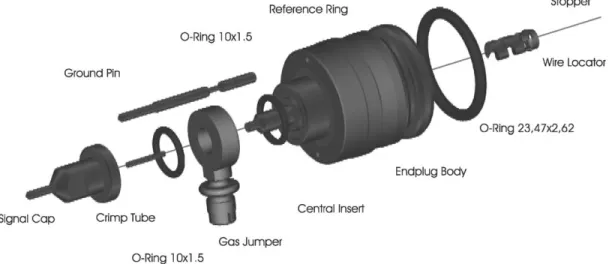The first precision drift tube chambers for the ATLAS muon spectrometer
F. Bauer
a,1, W. Blum
a, H. Dietl
a, S. Kotov
a,2, H. Kroha
a,*, A. Manz
a, A. Ostapchuk
a, R. Richter
a, S. Schael
a, S. Chouridou
b, D. Schaile
b, A. Staude
b,
R. Str ohmer .
b, T. Trefzger
b, K. Bouzakis
c, A. Krepouri
c, P. Paschalias
c, Ch. Petridou
c, D. Sampsonidis
c, I. Tsiafis
c, Ch. Valderanis
c, J. Wotschack
c,3,
R.M. Avramidou
d, M. Dris
d, E.N. Gazis
d, E.C. Katsoufis
d, S. Maltezos
d, G. Stavropoulos
d, D. Fassouliotis
e, P. Ioannou
e, C. Kourkoumelis
e, V. Birioukov
e,4, G.A. Chelkov
f, D.V. Dedovitch
f, P.G. Evtoukhovitch
f, A.L. Gongadze
f, M.I. Gostkin
f, D.V. Khartchenko
f, I.N. Potrap
f, E.V. Rogalev
f,
E.G. Tskhadadze
f, V.V. Zhuravlov
f, E. Diehl
g, D. Levin
g, S. McKee
g, H. Neal
g, G. Tarle
g, R. Thun
g, B. Zhou
gaMax-Planck-Institut fur Physik, Werner-Heisenberg-Inst. f. ur Physik, F. ohringer Ring. 6, D-80805Munich, Germany
bLudwig-Maximilians-Universitat, Schellingstraße 4, D-80799 Munich, Germany.
cAristotle University of Thessaloniki, GR-54006 Thessaloniki, Greece
dPhysics Department, National Technical University, GR-15780 Athens, Greece
eDepartment of Physics, University of Athens, GR-15771 Athens, Greece
fJINR, Dubna, 141980 Moscow Region, Russia
gPhysics Department, University of Michigan, Ann Arbor, MI 48108, USA
Abstract
The muon spectrometer of the ATLAS detector for the Large Hadron Collider is designed to provide a muon transverse momentum resolution of 2%210%for momenta between 6 GeV and 1 TeV over a pseudo-rapidity range of jZjp2:7: This required the development of precision drift chambers with a track position resolution of 40mm, the Monitored Drift Tube (MDT) chambers. We report about the construction of the three main types of MDT chambers for ATLAS, test results and the first production experience.r2002 Elsevier Science B.V. All rights reserved.
Keywords: ATLAS detector; Muon spectrometer; Drift chambers; Drift tubes
*Corresponding author.
E-mail address:kroha@mppmu.mpg.de (H. Kroha).
1Permanent address: CEA Saclay, F-91191 Gif-sur-Yvette Cedex, France.
2Permanent address: JINR, Dubna, 141980 Moscow Region, Russia.
3Permanent address: CERN, CH-1211 Geneva 23, Switzerland.
4Permanent address: IHEP, Protvino, 142284 Moscow Region, Russia.
0168-9002/02/$ - see front matterr2002 Elsevier Science B.V. All rights reserved.
PII: S 0 1 6 8 - 9 0 0 2 ( 0 1 ) 0 1 7 4 0 - 5
The Monitored Drift Tube (MDT) chambers for the ATLAS muon spectrometer [1] consist of 3 or 4 layers of precision aluminum drift tubes with 29:97070:015 mm outer diameter and 400mm wall thickness on either side of a space frame consisting of two longitudinal beams and three cross plates (see Fig. 1). Optical measurement systems inte- grated in the space frame monitor the planarity of the chamber. The drift tubes are operated at a gas pressure of 3 bar to provide a single-tube position resolution of at least 80mm with an Ar : CO2 (93 : 7) gas mixture at the low gas gain of 2104 required to prevent ageing of the drift tubes at the high background rates at the Large Hadron Collider (LHC). The sense wires of the drift tubes have to be positioned in the chamber with an accuracy of 20mm (rms).
In total, 1200 MDT chambers containing 400 000 drift tubes of 0.9–6.2 m length and cover- ing a total active area of 5500 m2 have to be constructed for the ATLAS muon spectrometer at
13 production sites over a period of 4 yr. We report about the construction of the three main types of MDT chambers in the ATLAS detector at the sites where the serial production has already started.
In Munich, 88 rectangular 6-layer chambers of up to 2.16 m width with, in total, 36 000 drift tubes of 3.8 m length (see Fig. 1) are being built for installation at the outer circumference of the barrel part of the muon spectrometer (type ‘BOS’). The drift tubes for these chambers are assembled and tested in a common facility at the Joint Institute for Nuclear Research in Dubna, Russia. For the innermost layer of the barrel spectrometer with the highest background rate, 128 rectangular 8-layer chambers of about 1 m width with, in total, 30 000 drift tubes of 1.7 m length (type ‘BIS’) are under construction in Thessaloniki in collaboration with groups at the University and the National Technical University of Athens where the drift tubes are assembled and tested. At the University of Michigan, 80 trapezoidal 6-layer chambers
Fig. 1. MDT chamber for the ATLAS muon spectrometer.
with, in total, 38 000 drift tubes of varying lengths of up to 5.8 m have to be built for the endcap part of the muon spectrometer.
The construction of a MDT chamber proceeds in two major steps, the fabrication of the drift tubes and the precise assembly of the tubes in the chamber. In order to position the sense wires at the drift tube ends with the required accuracy of 10mm (rms) an endplug with precisely machined refer- ence surfaces has been developed (see Fig. 2). The wire is located in a spiral hole, concentric with an outer aluminum reference ring, enabling auto- mated wire insertion. The insulating plastic (Nor- yl) body of the endplug is injection moulded in a carefully optimized process in order to prevent the development of cracks and gas leaks over time.
After drift tube assembly, the wire positioning accuracy was measured to be 7mm (rms) using stereo X-ray or electronic pickup methods. The drift tubes have to pass stringent quality control tests including measurements of the wire position, gas leak rate, wire tension and high-voltage leakage current. The drift tube rejection rate at the start of the serial production is below 2%:
For the assembly of a MDT chamber, the drift tubes for each layer are positioned on precision aluminum combs on a flat granite table in a temperature and humidity-controlled clean room (see Fig. 3). The positioning accuracy of the
aluminum reference rings of the endplugs is better than 5mm (rms).
In the case of the BOS MDT chambers, the tube layers are then glued successively to both sides of the space frame which for this purpose is positioned with respect to the combs on precision towers at the ends of each cross plate with an accuracy of 75mm in horizontal and in vertical direction (see Fig. 3). The gravitational deforma- tions of the cross plates during assembly of up to 100mm are compensated by 8 computer-controlled pneumatic pistons acting on the longitudinal beams. During glue curing, the tubes are held on the combs by vacuum suction.
For space reasons, the two quadruple layers of the BIS MDT chambers are separated by only 6 mm wide gap while the space frames of the endcap MDT chambers are designed for vertical installation of the chambers and show much larger gravitational deformations during assembly than in the case of the barrel chambers. In these cases, the tube layers are temporarily attached to a stiff auxiliary frame for glueing them to each other.
The space frame is inserted between the two triple layers of the endcap chambers in a final step.
The wire positions in the first BIS and the first BOS chamber have been measured at CERN in summer 2000 by scanning them perpendicular to the wires with stereo X-ray sources [2]. The wire
Fig. 2. Exploded view of the endplug for the MDT drift tubes providing precise wire positioning.
positioning accuracy was found to be 11mm (rms) for the BIS chamber and 14mm (rms) for the BOS chamber which is well within the required 20mm (rms). Similar results have been obtained in the meantime for the first chambers of several other production sites as well. With allowed variations in the wire tension and therefore in the wire sag of only 2% (rms), the wire positions in- between the chamber ends are even more precisely determined.
In the barrel chambers, the gravitational sag of the tube layers is adjusted by screws between the longitudinal beams and the middle cross plate such that it matches the sag of the wires for each chamber orientation. For most of the vertically installed endcap chambers, the tube curvature would have to be built in during glueing of the tube layers. With the aim of avoiding this complication, detailed studies are in progress to determine the effect of wire displacement from the drift tube center by up to 480mm for the longest tubes on the operation and resolution of the endcap chambers. Simulations show only minor
degradation of the average momentum resolution of the endcap muon spectrometer.
The first demonstration that the required mechanical precision can be achieved with meth- ods suitable for serial production was performed with the construction of a full-scale BOS prototype chamber at the Max-Planck-Institut [3] and with the subsequent X-ray measurement of the chamber at CERN in 1998 [2]. The chamber resolution under the nominal operating conditions was demonstrated with the prototype chamber in a 300 GeV muon beam at CERN in 1999. Using a silicon strip detector beam telescope as external reference, the space-to-drift-time relationship and the position resolution as a function of the drift distance were determined for the individual drift tubes. The average single-tube resolution at the modest interaction rates in the test beam was measured to be 70mm (rms). Applying this r2t- relationship to all drift tubes in the 11 m2 wide trigger area, the relative wire positions in the chamber plane could be determined using tracking information in each of the two triple layers. This
Fig. 3. Assembly facility for BOS MDT chambers with the first chamber under construction.
measurement and the X-ray measurement of the wire coordinates agree within 10mm (rms).
At almost all of the 13 construction sites the first MDT chamber has been assembled. The serial production of chambers for ATLAS has started in Munich (3 chambers completed), in Thessaloniki (10 chambers completed) and at the University of Michigan (7 chambers completed) together with the two other production sites in the United States.
The optimization of the assembly procedures for serial production is now in progress. In order to be ready for installation in the ATLAS detector in 2004 an MDT chamber has to be completed and tested within less than 2 weeks at most of the production sites.
Acknowledgements
We are indebted to the X-ray tomograph group at CERN for the prompt and accurate measure- ment of our chambers.
References
[1] A. Airapetian, et al., ATLAS Muon Spectrometer Technical Design Report, CERN/LHCC/97-22, May 1997.
[2] J. Berbiers, et al., Nucl. Instr. and Meth. A 419 (1998) 342.
[3] F. Bauer, et al., MPI Report, MPI-PhE/2000-11, May 2000, Nucl. Instr. and Meth. A 461 (2001) 17.


